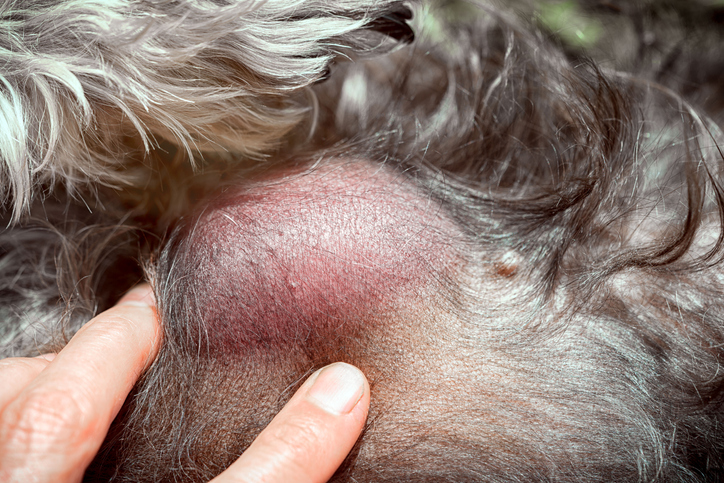Our dogs are part of our family. It is hard for any pet parent to learn that their beloved dog is diagnosed with a cancer called lymphoma. But what exactly is lymphoma and what are the symptoms of this cancer?
If you’re interested in learning about lymphoma in dogs, symptoms of lymphoma and treatments available, continue reading this article below.
What is Lymphoma?
Lymphoma is a form of cancer that attacks the lymph nodes and organs. It is one of the most common cancers in canines, with approximately 20% of all dog cancers being related to lymphoma.
The lymphatic system is responsible for circulating liquids throughout the body and straining out toxins or infections. When the lymph nodes are attacked, the immune system suffers a shock. The body’s defensive mechanisms attack the invading cancer by slowing the action of the lymphatic system which causes more damage to the immune system. Without treatment, the body will shut down within one to two months.
There are four distinct types of lymphoma that can occur in dogs.
- Systemic lymphoma is the most common form of the disease. It makes up 80% of all lymphatic cancer cases in canines. Systemic lymphoma attacks all the lymph nodes in the body.
- Alimentary lymphoma attacks the intestines and gastrointestinal tract.
- Mediastinal lymphoma invades the lymph nodes and organs in the chest.
- Extranodal lymphoma attacks organs outside of the lymphatic system, including the eyes and skin.
Even though lymphoma is cancerous, it does not cause much pain in an animal and therefore goes undiagnosed until the swelling of the lymph nodes is apparent.

Symptoms of Lymphoma in Dogs
In most cases, lymphoma is only diagnosed after a pet owner discovers a soft lump or bump under the skin of their pet. These lumps tend to appear first along the underside of the chin, down one or both sides of the throat, in the armpits and shoulders, and in the lower abdominal area .The lymphoma can appear as a single, isolated lump or as a cluster of small lumps of various sizes.
In cases of mediastinal lymphoma, the lumps will appear along the chest. The dog might develop a cough or a wheezing sound and get out of breath after the mildest activity.
If your dog is suffering from alimentary lymphoma, you might notice a sudden loss of appetite, weight loss, diarrhea, and weakness in the hind end.
If you find any lumps or bumps on your dog, bring them to the vet immediately for an exam. If you’re in the Keller, TX area, we are more than happy to see your pet and make sure they receive the utmost care if they are exhibiting symptoms of lymphoma.
How is Lymphoma Diagnosed?
Once you take your dog to the vet, a skilled veterinarian will be able to determine if the lumps are caused by lymphoma or another ailment. If lymphoma is suspected, an aspirated needle biopsy will be performed to study the cells within the lump.
An aspirated needle biopsy is done by stabbing the lump with a hollow needle, like the one used to draw blood, and sucking cells out of the lump into the syringe. The cells are then mounted on a slide and stained for a diagnosis. This also identifies the type of lymphoma your dog has and helps the vet determine the best course of treatment.
If the sample cannot be obtained with the needle biopsy, a surgical biopsy is necessary. A small portion of the lump is removed and sent to a lab for confirmation of cancer.
Treatment for Lymphoma
Chemotherapy
If the lab confirms that the dog has cancer, treatment will begin to help attack the cancer.
Regardless of the type of lymphoma, treatment is similar in all cases. Chemotherapy is the best method of killing the cancerous invasion. Dogs have less harsh negative reactions to chemotherapy than humans do. The drugs used are similar to the same drugs used in human treatment, but in much smaller doses. Combinations of different drugs seem to be more effective than a single medication.
If your veterinarian recommends chemo for your pet, the treatment usually takes place one time each week for two to six months. The first five to seven doses are the most potent and rapidly attack the cancer. The remaining doses gradually decrease in strength and the dog is weaned off the treatments after six months.
Steroids
While chemotherapy is the most effective treatment option, it is also the most expensive. Some pet owners cannot afford the treatment. The next treatment option available is steroids such as prednisone which can slow the spread of the disease and help shrink the lymph nodes. In rare cases, prednisone was enough to force the lymphoma into remission, but that outcome is unlikely.
Your veterinarian will be with you every step of the way and will help you make the decision that is best for your dog.

Quality of Life
Since lymphoma is a silent killer, it often goes undetected and dogs have a good life before the disease is diagnosed. There is no reason the dog should not continue to have that quality of life.
In dogs who were treated with chemotherapy, most experienced very minor side effects and were able to continue with the quality of life they were accustomed to. Symptoms associated with chemotherapy side effects include upset stomach, weight loss, and lethargy to a small degree. Because the dose is so small and processed so quickly through the canine bloodstream, the side effects are much less intense than in human patients.
After completing the full course of chemotherapy treatment, the dog can be expected to have an additional six to twelve months of life. Owners who choose this option realize that it does not remove the cancerous white blood cells. It merely offers the animal and the owner some additional time together while the cancer is in remission (not actively attacking the body).
If your dog is taking steroids instead to help control lymphoma, you may notice that they are drinking and urinating more. They may also pant more and may possibly drool.
No matter the treatment your pet receives, your veterinarian will guide you on steps to take to ensure they have a good quality of life. During this time, spend time with your dog and do all the things that they love. Your dog will be happy to spend time with you, whether that is cuddling, playing fetch, or going on walks. Take time out of your day for your dog.
Summary
No pet owners want to hear that their dog has lymphoma. There are treatment options available, but it is important to realize that lymphatic cancer is a fatal disease and will ultimately lead to the death of the pet. Chemotherapy treatment will lengthen the dog’s life by approximately one year compared to non-treatment, but it will not remove the cancer. Prednisone treatment will help shrink the lymph nodes, which may help the pet feel better, especially in cases of mediastinal lymphoma where the swelling affects breathing. Prednisone treatment can help extend the pet’s life by a few months. This extra time might allow pet parents to spend additional time with their pet and do things they love together.
If you notice any bumps or lumps on your pet, call us at (817) 421-5850. Here at Creekside Pet Care Center, we would be more than happy to care for your pet and answer any questions you may have!






